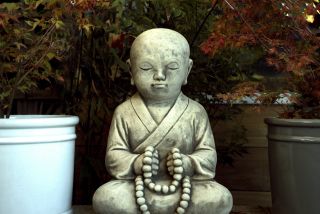Meditation
Forget What You Think You Know About Meditation
Select the right meditation for you, and you'll find it easier to stick with.
Posted January 1, 2024 Reviewed by Michelle Quirk
Key points
- Most people know that meditation would help them live and feel better.
- Many of us have tried meditation and given up because it seemed too difficult or "not for us."
- Learning about different meditation practices with specific benefits can help us select the right type for us.

Most of us would benefit from adopting a meditation practice. Nearly all of the clients I’ve worked with as a psychologist (and pretty much all the other humans I know) wish they had more control over their thoughts and emotional reactions. They long for less stress, more happiness and relaxation, and greater enjoyment and presence for their happier moments. They wish they behaved in ways that aligned with their goals and values. In short, they desire mental peace. And, yet, despite the promises of meditation to provide all of these benefits, most people I know have also attempted meditation and abandoned it in short order.
Why do people give up on meditation? Because it is hard! Or at least it can be if we approach it believing we’re supposed to be able to sit like a monk and clear our minds for 20 minutes at a stretch. For most of us, only 2 minutes without having a thought pop up is not realistic. And, so, after several sessions of sitting and growing frustrated that our minds uncontrollably pop from one thought to the next, we decide meditation isn’t for us, or it’s too hard, or that we can’t do it right. And we move on.
However, if we approach meditation with different expectations, we might find success. Instead of believing there is one right way to meditate, let’s dig into why we are meditating in the first place and reverse-engineer the meditation practice for us. After all, there are numerous styles of meditation. Perhaps one of the following is the right style for you:
- For stress reduction: Stress reduction can be achieved using numerous meditation styles. One that many people find approachable is a guided breathing meditation. This style of meditation is led by a teacher who helps to guide the process of relaxation through coaching on using the breath to signal the parasympathetic nervous system to relax the body. I recommend that you set a daily reminder on your phone to help you stick to a routine of meditation, ideally at times of day that are predictably stressful (e.g., midday at work) or at the end of the day, perhaps after work or before bed. Read on for more forms of meditation that are also known to reduce stress.
- For helping the body relax: Do you notice tension in your muscles, such as in your neck and shoulders? Progressive muscle relaxation is a process of flexing and relaxing our muscles, usually starting at the toes and moving upward to the face, in tandem with our breath. This is a powerful way to intentionally relax our muscles and signal the body that it’s time to relax. This form of meditation has been shown to help with stress, anxiety, sleep, and even chronic pain. I recommend trying progressive muscle relaxation before bed each night.
- For increased body connectivity: Body scan meditations are designed to help us connect to the subtle sensations in our bodies that are often overlooked in our busy day-to-day lives. Learning to notice and accurately read out body cues (such as subtle signs of fatigue, frustration, worry, or even hunger) can help us work skillfully with emotions as they are building, rather than waiting for them to build into a five-alarm fire before recognizing what's going on. Furthermore, grounding ourselves back into our bodies—and out of all the nonstop chatter in the brain—can help with stress, anxiety, and overall well-being and physical health. Guided body scan meditations often incorporate relaxing breath techniques. Movement meditations—including certain forms of yoga and tai chi—are also great for helping us connect to our bodies and breath. These forms of meditation can be especially helpful first thing in the morning, creating a ritual of body connection that helps us learn how to read subtle body cues and work with them throughout the day.
- For better concentration and attention skills: Mindfulness meditation has been shown to increase concentration and attention skills and preliminary studies suggest it may even be an effective treatment component for attention-deficit/hyperactivity disorder (ADHD) in adults and children (Bueno et al., 2015; Gonzales et al., 2023.) Mindfulness meditation is the form of meditation we usually think of when we think of “meditation.” It involves bringing our attention to a designated object—often the breath—and attempting to maintain our attention there. When we notice our minds wander elsewhere, we gently pull our attention back to the breath or object. This type of practice—like those above—reduces stress and anxiety and increases body awareness and overall sense of well-being, but it has the additional benefit of training our brains to decide what to concentrate on so that our attention isn’t pulled all over the place without our consent. You can think of this form of meditation as strength training for the brain, with the concentration benefits accruing over time with consistency.
- For reducing anxiety: If you suffer from anxiety, I can't recommend meditation enough. Acceptance practices, such as those practiced during meditation, are helpful for teaching us to allow anxious thoughts to arise and pass without attaching ourselves to them or interpreting them as truths. This is a powerful way to build a mental muscle for noticing thoughts or sensations and deciding whether or not to engage with them, based on their helpfulness to us in a given moment. Combine acceptance practices with the body relaxation and breathing meditation techniques above, and you are targeting the key symptoms of anxiety. If you're just starting out, or aren't sure if you're dealing with anxiety or something else (like trauma), I recommend working with a therapist while you build your meditation practices. Anxiety is one of the most common (and successfully treated) issues people come to therapy for, so don’t hesitate to reach out to a therapist if you’re struggling.
- For greater happiness: Gratitude meditations are a great way to increase happiness. Not only does eliciting gratitude make us feel better in the moment, but the act of searching for elements of our lives to be grateful for actually triggers neuroplasticity (brain changes) that allows us to experience gratitude with greater ease and frequency over time. This feels like greater happiness and appreciation for the lives we lead. I like to start and end my day with a brief gratitude practice, such as listing five things I'm grateful for.
- For a greater understanding of ourselves and the world around us: Insight or vipassana meditation is a form of meditation that teaches us to focus on what’s happening in the present moment, bringing our attention to subtle body sensations, the breath, or the sounds around us. This form of meditation is best practiced daily for at least 20–30 minutes, as the benefits come during longer sessions and gradually. Over time, we come to learn about how our brains work. For example, I have learned that my brain freaks out when I feel uncomfortable. Then I judge myself for freaking out. Then I remember to be compassionate. Then I smile and move on. While meditating, observing this pattern is interesting. Off the meditation cushion, however, understanding this pattern is profound. I can now notice the pattern unfold without getting stuck in any of the stages. Broader patterns about how the world works—such as how everything changes—begin to emerge with this form of meditation. The result of this practice, according to the Buddha, is wisdom. So if that’s what you seek, this is the meditation style for you.

The new year beckons us all to try something new. This year, I encourage you to try one of the forms of meditation from the above list. This is not an exhaustive list of all the forms of meditation that exist. These are the practices that I have found personally beneficial and those that have helped my clients and friends. I hope you find them accessible and that they benefit your lives in the coming year.
References
Bueno VF, Kozasa EH, da Silva MA, Alves TM, Louzã MR, Pompéia S. Mindfulness Meditation Improves Mood, Quality of Life, and Attention in Adults with Attention Deficit Hyperactivity Disorder. Biomed Res Int. 2015;2015:962857. doi: 10.1155/2015/962857. Epub 2015 Jun 7. PMID: 26137496; PMCID: PMC4475526.
Gonzalez NA, Sakhamuri N, Athiyaman S, Randhi B, Gutlapalli SD, Pu J, Zaidi MF, Patel M, Atluri LM, Arcia Franchini AP. A Systematic Review of Yoga and Meditation for Attention-Deficit/Hyperactivity Disorder in Children. Cureus. 2023 Mar 14;15(3):e36143. doi: 10.7759/cureus.36143. PMID: 37065343; PMCID: PMC10101238.
Insight Timer has dozens of excellent guided meditations.
Mindful Peace. Guided Mindfulness Meditation on Acceptance and Letting Go. YouTube.


